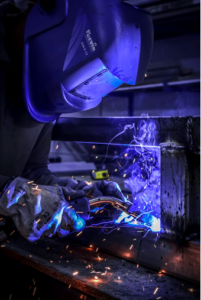
The Submerged Arc Welding (SAW) process has been around for over 60 years now as an extremely versatile and well established welding method. The process is suitable for applications where thick steels require long, continuous welds.
In this blog post, we’ll discuss the process, operating principle, and advantages of SAW.
Operation of Submerged Arc Welding Process
SAW involves the formation of an arc that’s created between a continuously-fed electrode and a workpiece. At the start of the welding action, the flow of current in the high resistance path creates intense heat, melting a path of flux surrounding the electrode. This forms a conducting pool. The molten filler then displaces the liquid flux, thereby fusing with the base metal and forming a weld.
The molten flux that has now coated the molten metal pool creates a shield-like blanket, protecting the weld from oxidation and eliminating spatter losses. As welding continues, the liquid flux cools down and the molten weld metal solidifies under the layer of unused flux.
Upon solidification, the molten flux creates a brittle slag layer, which is then easily removed.
Characteristics of SAW
Here are some key SAW process variables:
- Arc voltage
- Wire feed speed (significant factor in welding current control)
- Travel speed
- Power supply (440 V— AC/DC)
- Electric current (300 to 2000A)
- Contact tip to work (CTTW) or Electrode stick-out (ESO)
- Velocity (5m / Min)
Advantages of SAW
- Produces high quality metal welds with increased toughness, uniformity and ductility
- Thin metal plates can be welded in one go without any edge preparation. In other cases, slight beveling may be required.
- Extremely high deposition rate and speed of execution
- Uniform and smooth weld finish without splatter
- Minimal need for protective equipment and clothing because the arc is concealed
- Good utilization of the electrode wire
- Welds a variety of materials ranging from low carbon steel to high resistant and non ferrous metals like nickel, Monel metal, etc.
- Little to no smoke
- Easy automation
- Doesn’t typically require manipulative operating skills
- Offers high welding productivity because it is able to deposit up to 4–10 times weld per hour
 Top-Of-The-Line Welding Services in Wasilla, Alaska
Top-Of-The-Line Welding Services in Wasilla, Alaska
If you’re looking for a reliable metal fabrication platform for your welding, hardfacing and CNC plasma cutting, you’ve come to the right place.
In compliance with the highest industry standards, we offer an entire line of hardfacing services, ranging from GMAW, SAW, GTAW, and more.
Contact our team of certified welders today more details.
